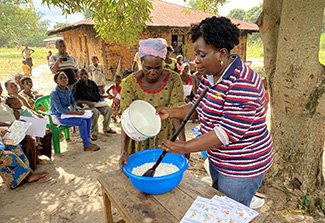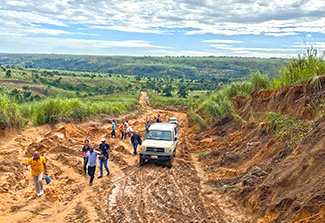Bitter cassava, bitter irony
November / December 2022 | Volume 21 Number 6
 Photo courtesy of Neerja VashistNutritionist Dr. Nicole Mashukano (right) teaches the wetting method to village women in Kahemba,which removes the toxic components of cassava.
Photo courtesy of Neerja VashistNutritionist Dr. Nicole Mashukano (right) teaches the wetting method to village women in Kahemba,which removes the toxic components of cassava.
By Susan Scutti
To get to Kahemba, site of Dr. Michael Boivin's konzo research program in the Democratic Republic of Congo (DRC), you begin in Kinshasa, DRC's capital city, and drive for two days until you reach a rural region near the Angolan border. Over the years, depending on economic and political conditions, people have moved back and forth between the two countries, Boivin explained: “It's with this movement and instability, if you will, that people fail to ferment, dry and process cassava sufficiently to eliminate the cyanide contained within it."
Failure to detoxify cassava places children at risk of konzo and malnourishment escalates the danger. “It's the perfect storm of toxic cassava flour as a food staple and no beans or animal protein sources for sulfur-based amino acids so that, if cyanide levels build up sufficiently within a short period of time, the poison penetrates the blood-brain barrier, causing permanent and irreversible neurological injury," said Boivin.
Damage to the upper motor neuron pathways in the brain results in paralysis. Boivin's recent research reveals that konzo has more extensive, if less visible, cognitive effects.
Colonial legacy
“Bitter cassava is not indigenous to the Congo basin. The Portuguese brought it from the Amazon in 1558 and it just thrived in Congolese soil," explained Boivin. "And, today, what's the option for millions of poor people who face famine due to drought or war? Starve… or eat bitter cassava and risk konzo."
Boivin has witnessed the effects of konzo since 1990, when a Fulbright scholarship brought him to DRC. He later revisited the country to complete an ecological analysis of konzo while working towards a public health degree at the University of Michigan. “Then in May of 1993, I planned to return to the DRC for an assignment with Thorkild Tylleskar, Hans Rosling, and their colleagues from Uppsala University in Sweden." At that time, the WHO described konzo as an upper motor neuron disease that did not affect cognition. “We suspected otherwise," said Boivin. The team set out to prove it, but before they could begin, civil conflict in the region forced them to evacuate.
Boivin turned his attention to cerebral malaria. Some time later, at a scientific conference, he presented his research of school-age children affected by that disease, when “a tall, formidable Congolese neurologist came up to me and said, 'We need this kind of work on our konzo project, would you write up a grant with me?'"
And so began Boivin's collaboration with
Desire Tshala.
Developmental delays
In 2011, parts of DRC became stable enough for the pair to begin “a multi-faceted research program" in Kahemba. Through 2017, Tshala and Boivin's team documented konzo's effects on development, constructing a portrait of affected, school-aged children. “Konzo is a disease of the most severe poverty. To extract early child development risk factors—nutritional, socioeconomic, educational, emotional, trauma from displacement, famine conditions—from the pure, primary effects of cassava cyanide exposure itself is tough."
 Photo courtesy of Neerja VashistThe road to Kahemba is at least a two-day drive from Kinshasa, the capital of the DRC.
Photo courtesy of Neerja VashistThe road to Kahemba is at least a two-day drive from Kinshasa, the capital of the DRC.
Continuing work in the region pioneered by Jean-Pierre Banea in the DRC Ministry of Health and Nutrition, Tshala and Boivin's team tested levels of urinary thiocyanate in people and levels of cyanide in the household cassava flour. (Urinary thiocyanate levels indicate how much cyanide people have ingested.) “We proved that higher levels of urinary thiocyanate within the moms (who prepare food and breastfeed) was associated with greater exposure to poorly processed cassava (and cyanide) and also developmental delays in their infants." The team, in partnership with Esperance Kashala-Abotnes at the University of Bergen in Norway, was the first to document overall cognitive delays in addition to motor delays from poorly processed cassava in infants and very young children.
These disturbing results raised an urgent question: How can konzo be prevented? “The only practical way is the wetting method," said Boivin. It was clear, though, that mothers who learned the method only practiced it for a time before returning to familiar tradition. “So, what do we do to get the moms to persist?"
Caregiver intervention
Previously, with funding from the Eunice Kennedy Shriver National Institute of Child Health and Human Development, Boivin's team had
adapted a caregiver training intervention for Ugandan mothers living with HIV. The Mediational Intervention for Sensitizing Caregivers (MISC) teaches mothers how to better care for their children, leading to improved developmental outcomes and survival rates for the children. “It's a year-long, every-other-week training package for moms," explained Boivin. “The moms had become sensitized and more attentive and astute in terms of the health care needs of their children," said Boivin.
Boivin hypothesized that it might encourage mothers towards sustainable use of the wetting method. “We took our two best Ugandan trainers and sent them to Kahemba, where they trained our field teams in MISC," said Boivin. Preliminary results show the program is making a difference. Flour cyanide levels and urinary thiocyanate levels are lower among the mothers who received the MISC intervention. “A first look seems to indicate that the moms are more motivated. The kids are doing better developmentally in language-related areas, which drives overall cognitive benefits."
“We're preventing konzo, a permanent, irreversible neurological disease, in the most abject impoverished setting you can imagine," said Boivin. If some mothers become peer leaders-trainers for the wetting method with MISC, the benefits could extend exponentially—to her family, her community, and beyond.
More information
Updated December 14, 2022
To view Adobe PDF files,
download current, free accessible plug-ins from Adobe's website.
Related World Regions / Countries
Related Global Health Research Topics